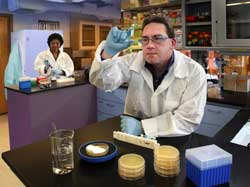



New Methods for Ensuring Food Safety
Agricultural Research Service researchers have developed technology to protect pasteurised liquid eggs from food safety threats, including Salmonella enteritidis.
Good news for fans of raw cookie dough. Researchers at Eastern Regional Research Center (ERRC) in Wyndmoor, Pennsylvania, have filed a patent on technology that can further protect pasteurised liquid eggs from food safety threats. These threats include both naturally occurring spoilage bacteria and pathogens such as Salmonella enteritidis, the primary cause of egg-related foodborne illness in the United States. The technology has also been successfully applied to milk.
But do not go running for that dough just yet. The US Food and Drug Administration (FDA) still cautions against consuming any raw, unpasteurised eggs or products that contain them.
Despite adherence to pasteurisation protocols prescribed by the US Department of Agriculture, illnesses related to consumption of raw egg products still occur. About 40,000 cases of salmonellosis are reported in the United States each year. The new ARS technology, developed by ERRC scientists, Sudarsan Mukhopadhyay, Peggy Tomasula and John Luchansky, may help reduce that number.
“Current pasteurisation technology is not adequate to remove all pathogens effectively from egg products,” says Tomasula, research leader of the ERRC Dairy Processing and Products Research Unit. “Though pasteurization eliminates heat-sensitive pathogens, some heat-resistant microorganisms can survive and spoil liquid egg whites.”

Consumers can avoid illness by properly handling and cooking eggs before consumption. But Dr Tomasula, along with lead scientist Dr Luchansky of the Microbial Food Safety Research Unit and chemical engineer, Dr Mukhopadhyay, has found that new technology can compensate for the shortcomings of thermal pasteurisation.
The technology, called 'crossflow microfiltration membrane separation' (CMF), removes more pathogens than thermal pasteurization does. And it does so without affecting the eggs’ ability to foam, coagulate, and emulsify – meaning that CMF-treated eggs could be safely substituted for pasteurized eggs in products where those characteristics are desired, such as angel food cake and mayonnaise. In a pilot-scale study, CMF was shown to remove about 99.9999 per cent of inoculated S. enteritidis from unpasteurised liquid egg whites.
The technology can also be used to remove Bacillus anthracis spores from egg whites. This finding adds to previous work in which ERRC researchers used CMF to remove 99.9999 per cent of B. anthracis spores inoculated into fluid milk. Microfiltration can also protect milk from more common bacterial pathogens, potentially extending its shelf life.
Though effective in its own right, CMF works best when treated as an accompaniment to pasteurization, not a replacement for it, says Tomasula. Combining the two processes significantly reduces the pathogen load.
May 2009











